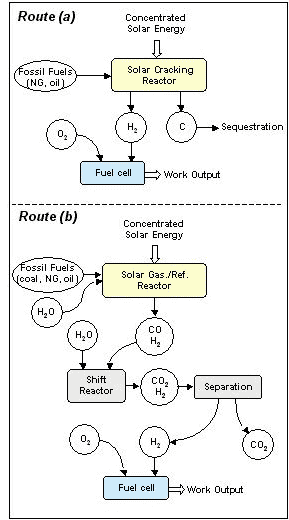Solar Hydrogen by Thermal Decarbonization of Fossil Fuels
Funding source: external page BfE - Swiss Federal Office of Energy, ETH-Project Nr. TH-29'/99-4
Background – Hybrid solar/fossil endothermic processes, in which fossil fuels are used exclusively as the chemical source for H2 production, and solar energy as the source of high-temperature process heat, offer viable and efficient routes for fossil fuel decarbonization and CO2 mitigation. The advantages of the solar-driven process are three-folded: 1) the discharge of pollutants is avoided; 2) the gaseous products are not contaminated; and 3) the calorific value of the fuel is upgraded.
Objective – Two decarbonization routes for H2 production from fossil fuels are investigated (see adjacent diagram):
(a) thermal cracking: CnHm = nC(gr) + (m/2)H2
(b) thermal gasification/reforming: CnHm + nH2O = nCO + (m/2+n)H2
Both routes proceed endothermically at T > 1500 K.
Milestones – The project encompasses:
1st phase) Establish the chemical boundary conditions for the solar reactor design and a base for evaluating the process efficiency.
2nd phase) Formulate solar reactor modeling and use it as a tool for pre-design and optimization.
3rd phase) Design, fabricate, and test a reactor prototype; determine its energy conversion efficiency; validate solar reactor modeling.
Collaboration – NREL (USA), University of Colorado (USA), Weizmann Institute of Science (IL)
Scientific and technological challenges
- Modeling radiation heat exchange in a gas-particle flow undergoing a heterogeneous chemical transformation, in which optical properties, species composition, and phases vary as the chemical reaction progresses. The gas-particle suspension is modeled as a non-gray non-isothermal absorbing-emitting-scattering media. Such modeling finds application in several other fields (e.g., combustion phenomena).
- Design of a high-temperature chemical reactor based on the direct high-flux irradiation of reactants. Reactor concept for route (a): vortex flow of natural gas laden with C(gr)-particles that serve as radiant absorbers and nucleation sites. Reactor concept for route (b): vortex-flow of steam laden with coal particles that serve as radiant absorbers and chemical reactants.
Project-related Publications
